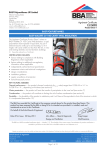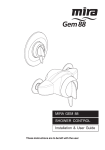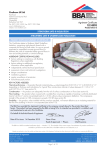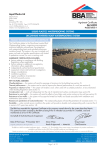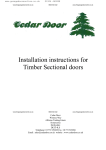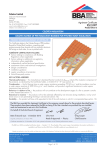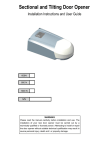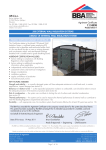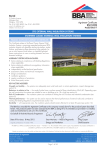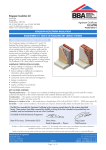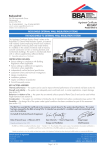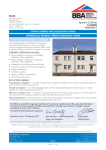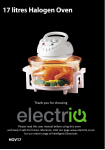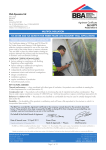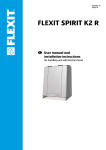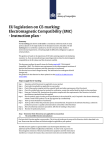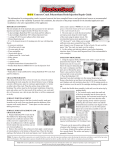Download BASF BBA Cert
Transcript
BASF Polyurethanes UK Ltd APPROVAL INSPECTION TESTING CERTIFICATION Alfreton Trading Estate Wimsey Way Somercotes Alfreton Derbyshire DE55 4NL Tel: 01773 601166 Fax: 01773 602089 TECHNICAL APPROVALS FOR CONSTRUCTION Agrément Certificate 11/4816 e-mail: [email protected] website: www.walltite.basf.co.uk Product Sheet 1 BASF POLYURETHANES WALLTITE PRODUCT SCOPE AND SUMMARY OF CERTIFICATE This Certificate relates to WALLTITE, a spray-applied expanding polyurethane foam, for use as an in-situ thermal insulation system for roofs, ground floors and external walls of new and existing domestic or similar buildings. It is for use in timber frame cavities, between and under timber rafters, and to the internal surface of masonry walls and concrete ground floors. AGRÉMENT CERTIFICATION INCLUDES: • factors relating to compliance with Building Regulations where applicable • factors relating to additional non-regulatory information where applicable • independently verified technical specification • assessment criteria and technical investigations • design considerations • installation guidance • regular surveillance of production • formal three-yearly review. KEY FACTORS ASSESSED Practicability of installation — the product must only be installed by contractors trained and approved by the Certificate holder (see section 4). Thermal performance — when installed at an appropriate thickness, the product can enable elements to meet or improve on U values specified for notional and existing buildings (see section 5). Condensation risk — the product has a water vapour resistivity of approximately 306 MN·s·g–1·m–1 but the risk of interstitial condensation will depend on the construction and should be assessed for each project (see section 6). Behaviour in relation to fire — roof, floor and wall systems using this product can be designed to meet UK requirements (see section 7). Durability — the durability of the product is satisfactory and will have a life equivalent to that of the structure in which it is incorporated (see section 13). The BBA has awarded this Agrément Certificate to the company named above for the product described herein. The product has been assessed by the BBA as being fit for its intended use provided it is installed, used and maintained as set out in this Certificate. On behalf of the British Board of Agrément Date of First issue: 21 February 2011 Simon Wroe Head of Approvals — Physics Greg Cooper Chief Executive The BBA is a UKAS accredited certification body — Number 113. The schedule of the current scope of accreditation for product certification is available in pdf format via the UKAS link on the BBA website at www.bbacerts.co.uk Readers are advised to check the validity and latest issue number of this Agrément Certificate by either referring to the BBA website or contacting the BBA direct. British Board of Agrément Bucknalls Lane Garston, Watford Herts WD25 9BA ©2011 Page 1 of 16 tel: 01923 665300 fax: 01923 665301 e-mail: [email protected] website: www.bbacerts.co.uk Regulations In the opinion of the BBA WALLTITE, if used in accordance with the provisions of this Certificate, will meet or contribute to meeting the relevant requirements of the following Building Regulations: The Building Regulations 2010 (England and Wales) Requirement: A1 Loading Comment: Requirement: C2(c) Resistance to moisture Masonry floors incorporating the product can meet this Requirement. See section 10 of this Certificate. Comment: The risk of interstitial condensation must be assessed for each construction. The product can adequately limit the risk of surface condensation. See sections 6.1 and 6.7 of this Certificate. Requirement: L1(a)(i) Conservation of fuel and power Comment: Requirement: Regulation 7 Materials and workmanship Comment: The product is an acceptable material. See section 13 and the Installation part of this Certificate. The product can contribute to meeting this Requirement. See sections 5.1 and 5.2 of this Certificate. The Building (Scotland) Regulations 2004 (as amended) Regulation: 8(1) Regulation: Standard: 9 1.1(a)(b) 3.15 6.1(b) 6.2 Carbon dioxide emissions Building insulation envelope The product can contribute to a roof, floor or wall satisfying these Standards, with reference to clauses, or parts of, 6.1.1(1), 6.1.2(2), 6.1.3(1), 6.1.6(1), 6.2.1(1)(2), 6.2.3(1), 6.2.4(2), 6.2.5(2), 6.2.6(1), 6.2.7(1), 6.2.8(1)(2) to 6.2.11(1)(2), 6.2.12(2) and 6.2.13(1)(2). See sections 5.1 and 5.2 of this Certificate. Comment: Regulation: Condensation The risk of interstitial condensation must be assessed for each construction. The product can adequately limit the risk of surface condensation, with reference to clauses 3.15.1(1)(2), 3.15.3(1)(2), 3.15.4(1)(2), 3.15.5(1)(2), 3.15.6(1)(2) and 3.15.7(1)(2). See sections 6.1 and 6.8 of this Certificate. Comment: Standard: Standard: Building Standards — construction Structure Masonry floors incorporating the product can meet this Standard, with reference to clause 1.1.1(1)(2). See section 10 of this Certificate. Comment: Standard: Fitness and durability of materials and workmanship The product can contribute to a construction satisfying this Regulation. See section 13 and the Installation part of this Certificate. Comment: 12 Building standards — conversions All comments given for these products under Regulation 9, also apply to this Regulation, with reference to clause 0.12.1(1) and Schedule 6(1). Comment: (1) Technical Handbook (Domestic). (2) Technical Handbook (Non-Domestic). The Building Regulations (Northern Ireland) 2000 (as amended) Regulation: B2 Fitness of materials and workmanship Comment: Regulation: C5 Condensation Comment: Regulation: D1 Stability Comment: Regulation: Regulation: F2(a)(i) F3(2) Conservation measures Target carbon dioxide Emissions Rate Comment: The product is acceptable. See section 13 and the Installation part of this Certificate. The risk of interstitial condensation must be assessed for each construction. See section 6.1 of this Certificate. Masonry floors incorporating the product can meet this Regulation. See section 10 of this Certificate. The product can contribute to meeting these Regulations. See sections 5.1 and 5.2 of this Certificate. Construction (Design and Management) Regulations 2007 Construction (Design and Management) Regulations (Northern Ireland) 2007 Information in this Certificate may assist the client, CDM co-ordinator, designer and contractors to address their obligations under these Regulations. See sections: 2 Delivery and site handling (2.1 to 2.3) and 14 Precautions (14.1 to 14.6) of this Certificate. Non-regulatory Information NHBC Standards 2011 NHBC accepts the use of WALLTITE, when installed and used in accordance with this Certificate, in relation to NHBC Standards, Chapter 5.1 Substructure and ground bearing floors Chapter 5.2 Suspended ground floors, Chapter 6.1 External masonry walls, Chapter 6.2 External timber framed walls, Chapter 7.1 Flat roofs and balconies and Chapter 7.2 Pitched roofs. Page 2 of 16 General WALLTITE is a registered trademark of BASF Polyurethanes UK Ltd. Technical Specification 1 Description 1.1 WALLTITE comprises a spray applied HFC blown, rigid polyurethane foam which can be applied to pitched timber roofs, including hybrid(1) roofs, flat timber roofs, concrete ground-floor constructions, timber-frame stud walling and the internal surfaces of external masonry walls. (1) Hybrid roofs contain both sloping and horizontal insulation. 1.2 The foam is prepared by mixing two liquid components, (one part by volume of isocyanate to one part by volume of resin) within the nozzle of the spray gun during the spraying process. The thermal insulation system is built up in layers not exceeding 20 mm in thickness, until the required thickness is achieved. It is fully cured within two hours. 1.3 Quality control arrangements on site include checks on density and appearance. 1.4 Ancillary items used with the product, but outside the scope of this Certificate include: • BASF rafter slides — corrugated cardboard used to create a 50 mm ventilation gap between the bitumen felt/ sarking board and WALLTITE • BASF ventilator – a polyvinyl chloride ventilator, used at the eaves and/or ridge to create a 50 mm ventilation gap between the bitumen felt/sarking board and WALLTITE. It also keeps the eaves clear of WALLTITE. 2 Delivery and site handling 2.1 The two components are delivered to site in drums (up to 250 kg capacity) bearing the product name, batch number and the BBA identification mark incorporating the number of this Certificate. 2.2 Drums should be stored in a well-ventilated area, ideally above 10°C and away from possible ignition sources. The drums must be protected from frost. 2.3 The isocyanate component is classified as ‘harmful’, under The Chemicals (Hazard Information and Packaging for Supply) Regulations 2009 (CHIP4) and drums bear the appropriate hazard warning sign. When cured, the product does not constitute a health hazard. Assessment and Technical Investigations The following is a summary of the assessment and technical investigations carried out on WALLTITE. Design Considerations 3 General 3.1 WALLTITE is satisfactory for use as an insitu thermal insulation system to reduce the thermal transmittance (U value) of roofs, floors and walls in new or existing domestic, or similar buildings. 3.2 The product can be used: • between timber rafters only • between and under timber rafters • as a combination between and under timber rafters and between ceiling joists in a non-habitable roof (hybrid roof, which contain both sloping and horizontal insulation) • between timber joists in flat roofs • Concrete ground floors • between the studs of conventional timber-frame external wall constructions • between the void created by timber battens on the internal face of external masonry(1) walls, and lined with plasterboard. (1) Masonry constructions include clay and calcium silicate bricks, concrete blocks, and natural and reconstituted stone blocks. It is essential that such walls are constructed having regard to the local wind-driven rain index. 3.3 New constructions must be designed in accordance with • BS 5250 : 2002 • BS 5534 : 2003 • BS 8102 : 2009 • BS 8103-3 : 1996 • BS 8215 : 1991 • BS 8000-3 : 2001 • BS EN 1996-1-1 : 2005 • BS EN 1996-1-2 : 2005 the relevant recommendations of: • BS 5628-3 : 2005 • BS 6229 : 2003 • BS 8204-1 : 2003 • BS 8204-2 : 2003 • BS 8000-9 : 2003 • BS EN 1995-1-1 : 2004 • BS EN 1996-2 : 2006 • BS EN 1996-3 : 2006. (1) Further information is given in BRE Report (BR 262 : 2002) Thermal insulation : avoiding risks. Page 3 of 16 3.4 Existing constructions must be in a good state of repair with no evidence of rain penetration or damp. Defects must be made good prior to installation. 3.5 If present, mould or fungal growth must be treated prior to the application of the product. 3.6 The product must not come into direct contact with flue pipes, chimneys or other heat producing appliances (see section 8). 3.7 It is essential that construction elements are designed and constructed to incorporate normal precautions against moisture ingress before the application of the product. 3.8 The product forms a strong bond with clean and dry substrates. This should be taken into account when specifying the product or anticipating future alterations. 3.9 The product can contribute to the airtightness of the building envelope. 3.10 To satisfy the requirements of NHBC, a vapour control layer (VCL) of a type specified in their Standards must be applied behind the plasterboard lining in roof and wall applications, and the product must only be applied to a roof construction incorporating a breathable roof tile underlay. Pitched roofs, including hybrid roofs tiled or slated to BS 5534 : 2003 3.11 The product can be applied directly to breathable roof tile underlays, or to the BASF rafter slides and BASF ventilators which create a ventilation gap between the insulation and the bitumen felt/sarking board. Additionally, the product is applied to plasterboard, between ceiling joists to create a hybrid roof. 3.12 Care must be taken to ensure the integrity of the roof tile underlay drape when spraying the product (see section 15.4). 3.13 Pitched roofs are defined for the purpose of this Certificate as those roofs having a pitch in excess of 15°. Concrete ground floor constructions 3.14 The product must not be used where it may come into contact with moisture from the ground. 3.15 Ground-supported concrete floors incorporating the product must include a suitable damp-proof membrane (dpm) laid in accordance with the relevant clauses of CP 102 : 1973, BS 8102 : 1990 and/or BS 8215 : 1991. 3.16 Concrete ground floors incorporating the product must include a dpm or suitable ventilation of the sub-floor as appropriate. 3.17 The overlay should be: • a cement-based floor screed, laid in accordance with the relevant clauses of BS 8204-1 : 2003 and/or BS 8204-2 : 2003, and BS 8000-9 : 2003, or • a concrete slab in accordance with BS 8204-1 : 2003 and BS 8204-2 : 2003. External masonry walls (insulated dry lining) 3.18 Insulated dry lining systems require careful detailing during installation around doors and windows to achieve a satisfactory surface for finishing. In addition, every attempt should be made to minimise the risk of thermal bridging at reveals and where heavy separating walls are attached to the external wall. New work must be designed to accommodate the thickness of the dry lining, particularly at reveals, heads, sills and in relation to ceiling height. Where the dimensions of fixtures are critical (eg bathrooms) these should be checked before installation. 3.19 It is recommended that services which penetrate the dry lining, eg, light switches, power outlets, are kept to a minimum to limit damage to vapour checks. External walls (timber-frame) 3.20 Constructions incorporating a masonry outer leaf (such as masonry units and natural stone blocks) should be in accordance with BS EN 1996-1-1 : 2005, BS EN 1996-1-2 : 2005, BS EN 1996-2 : 2006, BS EN 1996-3 : 2006, BS 5628-3 : 2005 and BS 8000-3 : 2001. The designed residual cavity width should be 50 mm wide. 3.21 It is recommended that services which penetrate the dry lining, eg, light switches, power outlets, are kept to a minimum to limit damage to vapour checks. In addition, any penetrations should be either enclosed in plasterboard or stone mineral wool or suitably tested proprietary fire-rated systems in order to preserve the fire resistance of the wall. 3.22 Installation must not be carried out until the moisture content of the timber frame is less than 20%. 4 Practicability of installation The product must only be installed by contractors trained and approved by the Certificate holder in accordance with the Certificate holder’s Installation Manual. 5 Thermal performance 5.1 Calculations of the thermal transmittance (U value) should be carried out in accordance with BS EN ISO 6946 : 2007 and BRE Report (BR 443 : 2006) Conventions for U-value calculations using the thermal conductivity values in Table 1. Example U values for pitched roofs, flat roofs, floors and walls are given in Tables 2 to 4 and typical design roof, floor and wall U values in Tables 5 to 7. Fortuitous air infiltration in hybrid roofs increases the heat loss from the loft void and should be accounted for by adding a 10% correction factor to the calculated roof U value (see Table 3). Page 4 of 16 Table 1 Thermal conductivity Insulation thickness (mm) Thermal conductivity (W·m–1·K–1) <80 0.027 80 to 120 0.026 >120 0.025 Table 2 U values (1) for pitched and flat roofs and timber frame walls Element type Timber dimensions (mm) WALLTITE insulation (mm) and location with respect to rafter/joist/batten or stud Existing sloping roof with ventilated space below underlay Rafters = 50 x 150 at 400 centres Battens (inside) = 47 x 100 at 600 centres New sloping roof with LR underlay Rafters = 47 x 200 at 600 centres Flat timber roof Joists = 50 x 150 at 400 centres Timber frame wall (1) (2) (3) (4) (5) U value (W·m–2·K–1) inside between 100 50 0.20 (2) 26 141 161 185 200 0.20 0.18 0.16 0.13 7(3) 20(2) 50(4) 150 150 150 0.20 0.18 0.15 32(5) 92 102 121 140(3) 140 0.30 0.28 0.25 0.22 0.19 Studs = 38 x 140 at 600 centres Plasterboard taken as 12.5 mm at 0.25 W·m–1·K–1 and all timber % taken from BR 443. Timber batten = 47 mm x 30 mm at 600 mm centres. Timber batten = 47 mm x 22 mm at 600 mm centres. Timber batten = 47 mm x 60 mm at 600 mm centres. Timber batten = 47 mm x 32 mm at 600 mm centres. Table 3 Hybrid pitched roof U values including a 10% correction factor, calculated to section 8 of BR 443 : 2006 (Insulation at rafter level – flat ceiling) Roof pitch (θ): U value (W·m–2·K–1) 20 30 40 50 60 0.18 0.18 0.19 0.20 0.22 Note: Assuming construction of roof (external to internal): • 100 mm WALLTITE (91.6% )/100 mm deep timber rafters • loft void air cavity resistance 0.16 m2·K·W–1 • 100 mm WALLTITE (91.6%)/timber ceiling joists • plasterboard – 12.5 mm. Table 4 Slab on ground support U values (1)(2) P/A (perimeter/area) Insulation thickness (mm) Construction U value (W·m–2·K–1) 0.20 50 0.20 0.25 50 0.22 0.30 50 0.24 0.25 75 0.18 0.30 75 0.20 0.45 75 0.22 0.70 75 0.25 0.35 120 0.15 0.90 120 0.18 (1) Edge insulation not included. (2) Wall thickness (w) 0.3 m. Page 5 of 16 Table 5 Mean design roof, floor and wall U values — England and Wales (1) Construction U value (W·m–2·K–1) Existing building – new or replaced floor or wall Existing building – renovated or retained floor or wall Existing building – new, replaced, renovated or retained roof(2) Notional dwelling Existing building – new, replaced, renovated or retained roof(3) Notional non-domestic building Dwelling new-build limit Non-domestic new-build limit Roof Floor Wall — — 0.16 0.16 0.18 0.18 0.20 0.25 0.22 0.25 –– 0.25 — 0.22 0.25 0.25 0.28 0.30 –– 0.35 — 0.26 0.30 0.35 (1) Flexible approaches on existing buildings are given in the Approved Documents. (2) Hybrid pitched roof. (3) Pitched roof – insulation at rafter level. Table 6 Mean design roof, floor and wall U values – Scotland (1) Construction U value (W·m–2·K–1) Notional dwelling New dwelling simplified method Conversion unheated building (into dwellings)(2) Extension to dwelling(2) Conversion of unheated building (into dwellings)(3) Extension to dwelling(3) Alterations and reconstructions to a dwelling(2) Stand-alone building < 50 m2 to a dwelling(2) New non-dwellings limit for shell and fit out Conversion of unheated building Non-domestic extension, alterations and reconstructions Notional non-dwelling(4) Alterations and reconstructions to a dwelling(3) Stand-alone building < 50 m2 to a dwelling(3) New dwelling limit New non-domestic limit Notional non-dwelling(3) Conversion of heated building (1) (2) (3) (4) Roof Floor Wall 0.13 0.13 0.13 0.13 0.15 0.15 0.15 0.15 0.15 0.15 0.15 0.16 0.18 0.18 0.18 0.20 0.25 0.25 0.15 0.15 0.15 0.15 0.15 0.15 0.18 0.18 0.20 0.20 0.20 0.25 0.18 0.18 0.20 0.22 0.25 0.25 0.19 0.19 0.19 0.19 0.19 0.19 0.22 0.22 0.23 0.25 0.25 0.30 0.22 0.22 0.25 0.27 0.30 0.30 Flexible approaches on existing buildings are given in the Technical Handbooks. Hybrid pitched roof. All other roof insulation. Pitched roof. Table 7 Mean design roof, floor and wall U values – Northern Ireland (1) Construction U value (W·m–2·K–1) Existing building – new, replaced, renovated or retained roof Notional dwelling Existing building – new, replaced, renovated or retained roof (3) Existing building – new roof (4), floor or wall Building new-build limit Notional non-domestic building Existing building – replaced, renovated or retained roof (4), floor or wall (2) Roof Floor Wall 0.16 0.16 0.20 0.20 0.25 0.25 0.25 –– 0.25 — 0.22 0.25 0.25 0.25 –– 0.35 — 0.30 0.35 0.35 0.35 (1) Flexible approaches on existing buildings are given in the Technical Booklets. (2) Hybrid pitched roof. (3) Pitched roof – insulation at rafter level. (4) Flat roof. Page 6 of 16 5.2 The product can maintain, or contribute to maintaining, continuity of thermal insulation at junctions between elements and openings. Default psi values in BRE Information Paper IP1/06 Assessing the effects of thermal bridging at junctions and around openings, Table 3 may be used in carbon emission calculations in Scotland and Northern Ireland. Detailed guidance for other junctions and on limiting heat loss by air infiltration can be found in: England and Wales — Approved Documents to Part L and for new thermal elements to existing buildings, Accredited Construction Details (version 1.0). See also SAP 2009 Appendix K and the iSBEM User Manual for new-build Scotland — Accredited Construction Details (Scotland) Northern Ireland — Accredited Construction Details (version 1.0). 6 Condensation risk Interstitial condensation 6.1 Roofs, floors and walls should be designed and constructed in accordance with the relevant parts of BS 5250 : 2002 and Annex D, and BRE Report (BR 262 : 2002) for roofs and floors in England and Wales, including a well-sealed ceiling for the roof application, or BS EN 15026 : 2007, using the approximate water vapour resistivity value of 306 MN·s·g–1·m–1 for the product. 6.2 It is essential that roof, floor or wall design, construction and maintenance not only limits opportunities for vapour migration by diffusion but also by convection through gaps, cracks and laps in air/vapour control layers and through penetrations. This is particularly important for roofs which include layers of high resistance to vapour diffusion on both sides of the insulation layer. 6.3 Care should be taken to provide adequate ventilation, particularly in rooms expected to experience high humidity. Roofs 6.4 Dynamic simulations to BS EN 15026 : 2007 indicate that the VCL properties (with sealed laps) detailed in Table 8 are acceptable in roofs with no penetrations. The suitability of other constructions may be assessed by using an appropriate dynamic modelling package, see section 16.2. Table 8 Vapour control layer properties VCL equivalent air layer thickness sd (m) VCL water vapour resistance (MN·s·g–1) Roof type 10 50 Flat roof 10 50 Hybrid pitched roof 6.5 If the product is installed in roofs with bitumen felt/sarking board, a ventilation gap, minimum 50 mm from eaves to ridge must be provided to the underside of the roof tile underlay and the upper face of the insulation, unless a vapour permeable underlay is used. 6.6 Inadvertent air infiltration in hybrid roofs contributes to reducing the risk of interstitial condensation. Surface condensation 6.7 Roofs, floors and walls will adequately limit the risk of surface condensation where the thermal transmittance (U value) does not exceed 0.7 W·m–2·K–1 for walls and floors and 0.35 W·m–2·K–1 for roofs at any point and the junctions are designed in accordance with Limiting thermal bridging and air leakage : Robust construction details for dwellings and similar buildings TSO 2002, BRE Information Paper IP1/06 or section 5.2 of this Certificate. 6.8 Roofs, floors and walls designed to BS 5250 : 2002, Section 8, will adequately limit the risk of surface condensation where the thermal transmittance (U value) does not exceed 1.2 W·m–2·K–1 at any point. Guidance may by obtained from, BRE Report (BR 262 : 2002) and section 5.2 of this Certificate. 7 Behaviour in relation to fire 7.1 The internal face of the installed product achieved a Class 1 surface spread of flame rating when tested in accordance with BS 476-7 : 1997. 7.2 The product must be protected from naked flames and other ignition sources during and after installation (see also sections 9.1, 9.2 and 14.5). 7.3 When installed, the product will be contained by a suitable lining board, eg 12.5 mm plasterboard, with all joints fully sealed and supported by rafters, noggins or battens. Therefore, it will not contribute to the development stages of a fire until the lining is compromised. Alternatively, the rafters and the insulation foam in the pitched roof application may remain exposed after conducting a condensation risk analysis in accordance with section 6. Although the insulation foam has a class 1 surface spread of flame rating to BS 476-7 : 1997, it could contribute to the development stages of a fire, however to a limited extent in the early stages of the fire. 7.4 Elements must incorporate cavity barriers at edges, around openings, at junctions with fire resisting elements and in cavities in accordance with the relevant provisions of the national Building Regulations and relevant purpose group. The design and installation of cavity barriers must take into account any anticipated differential movement. Page 7 of 16 External timber frame walls 7.5 The product can be added to the void between studwork, or used as a substitute for glass mineral wool, in any loadbearing, timber-framed inner leaf to a double leaf wall system providing that: • the outer leaf is masonry, and • the existing inner leaf system has been shown to satisfy the loadbearing capacity performance criterion of BS 476-21 : 1987 or BS EN 1365-1 : 1999 for the required fire resistance period. 7.6 The suitability of constructions other than those described in section 7.5 should be demonstrated by an appropriate test or assessment. Roofs 7.7 The use of the product in a tiled pitched roof does not affect it’s external rating when evaluated by assessment or test to BS 476-3 : 2004. 8 Proximity of flues and appliances When installing the product in close proximity to certain flue pipes and/or heat producing appliances, the relevant provisions of the national Building Regulations are applicable: England and Wales — Approved Document J, sections 1 to 4 Scotland — Mandatory Standard 3.19, clauses 3.19.1(1)(2) to 3.19.9(1)(2) (1) Technical Handbook (Domestic). (2) Technical Handbook (Non-Domestic). Northern Ireland — Technical Booklet L, sections 1 to 4. 9 Materials in contact — Wiring installations 9.1 De-rating of electric cables should be considered in areas where the product restricts the flow of air. Where the foam is likely to bond to electric cables, suitable conduit or trunking must be used. 9.2 Recessed lighting must not be used with this form of insulation. 10 Floor loading The product, when covered with a suitable floor covering, is capable of resisting a uniformly distributed load of < 1.5 kN·m–2 and a concentrated load of < 1.4 kN for category A1 and type A situations for domestic and residential activities as defined in NA to BS EN 1991-1-1 : 2002, Tables NA.2 and BS 6399-1 : 1996, Table 1 respectively. Further assessment is necessary in the case of duty walkways and floors subject to physical activities. 11 Moisture penetration 11.1 The product must be used above the dpm and must not be used where it may come into contact with moisture from the ground. 11.2 For floors subject to national Building Regulations, construction should be as detailed or designed in accordance with: England and Wales — Approved Document C, Section 4 Scotland — Mandatory Standard 3.4, clauses 3.4.2(1)(2) to 3.4.4(1)(2) and 3.4.6(1)(2) (1) Technical Handbook (Domestic). (2) Technical Handbook (Non-Domestic). Northern Ireland — Technical Booklet C, Section 1. 12 Maintenance The product once installed does not require any regular maintenance and has suitable durability (see section 13), provided the waterproof layers are inspected and maintained at regular intervals. In pitched roof applications when the foam is exposed, any accidental damage that occurs can easily be rectified by the Certificate holder. 13 Durability The durability of the product is satisfactory and will have a life equivalent to that of the structure in which it is incorporated. Installation 14 Precautions 14.1 The installation process may produce a build-up of harmful vapours, and ventilation must be provided. It is required that all personnel in the area for treatment wear the correct protective clothing, breathing equipment and gloves. The Certificate holder’s instructions must be followed at all times. Page 8 of 16 14.2 Vapours given off by certain components, ie 4,4’ diphenylmethane diisocyanate (MDI), are generally heavier than air and will tend to move to lower parts of the building. These parts should be suitably ventilated. 14.3 If vapour levels need to be measured, methods should be those recommended by the Health and Safety Executive. Certain applications, ie confined roofs, require the use of extractor fans as recommended by the Certificate holder. 14.4 To comply with the requirements of Section 4 of the Health and Safety at Work Act 1974, it is essential that there is an exchange of information between the client and the installer before spray operations commence on any site. Existing health hazards and those brought into the premises by the installer should be discussed and measures agreed to deal with them effectively. 14.5 After installation in loft voids, fire warning labels must be placed in prominent positions if the foam is to be left exposed. The foam is a combustible material; adequate precautions should be taken to avoid ignition at all times. 14.6 To prevent the product from entering the occupied space, the loft hatch/cover must be kept closed during the spraying process. Protective covers must be placed over water tanks to prevent contamination and blockage during application, and should not be removed until sufficient time has elapsed for potentially harmful vapours to be ventilated from the roof space. 15 Procedure General 15.1 Building elements to be insulated must be assessed for suitability and any necessary repairs carried out. Elements must be weather tight before the application of the product. The positioning and access to services should also be considered. 15.2 Access boards and lighting should be positioned in the roof void. 15.3 Where there is no provision made for ventilation of the space, care should be taken to ensure that ingress of moisture vapour from the dwelling space below is restricted (see also sections 6.1 and 6.2). Between rafters application — breathable roof tile underlay (see Figure 1) 15.4 The product should be spray applied to clean and dry substrates in a flash coat, <10 mm thick. Care must be taken to ensure the integrity of the roof tile underlay drape. Subsequent coats not exceeding 20 mm thick are applied once the foam reaction has occurred, and within 10 minutes of the previous coat being applied, until the required total thickness is achieved. Figure 1 Typical pitched roof application roof tile underlay Walltite plasterboard VCL 15.5 Where additional insulation to that provided in sections 15.4, 15.6 and 15.7 is required, insulation can be placed between the horizontal ceiling joists in the form of mineral wool or WALLTITE, after conducting a condensation risk analysis in accordance with section 6. Page 9 of 16 Between rafters application – bitumen felt/sarking board 15.6 BASF ventilator spacers are tightly fitted at the eaves to fully fill the space between the rafters (see Figure 2). BASF rafter slides are then stapled to the internal face of the rafters, leaving a minimum 25 mm of rafter exposed below the edges of the BASF rafter slides for the foam to adhere to (see Figure 3). A 50 mm deep ventilated void (minimum of 25 mm at the centre of the underlay drape and the BASF ventilator spacers/BASF rafter slides) must be maintained. The foam is spray applied to the depth of the rafters as in section 15.4. Figure 2 BASF ventilator spacer detailing BASF rafter slide Walltite BASF ventilator spacer Figure 3 BASF rafter slide detailing BASF rafter slide Walltite BASFventilator spacer roof tile underlay Between and below rafters 15.7 The foam is applied by spray to the depth of the rafters as shown in section 15.4. Cross-battens are then mechanically fixed to the rafters. The battens must be of sufficient width and spacing (up to 600 mm) to provide adequate support to which the plasterboard can be mechanically fixed. Filling then resumes in 20 mm thick layers. Page 10 of 16 Flat roofs 15.8 The product is sprayed directly to the underside of the roof deck, as described in section 15.4. Ground Floors 15.9 All concrete floor surfaces should be smooth, level and flat to within 5 mm when measured with a 2 m straightedge. Irregularities greater than this must be removed, whilst minor irregularities (up to 10 mm deep) may be levelled with mortar or thin screed. 15.10 In ground-supported concrete floors, the concrete floor slab over which the product is spray applied should be left for as long as possible to maximise drying out and dissipation of construction moisture, in accordance with BS 8203 : 2001, Section 3.1.2. 15.11 Where the product is used over ground-supported concrete floor slabs a suitable dpm in accordance with CP 102 : 1973, Section 11 and BS 8204-1 : 2003 or BS 8204-2 : 2003 should be laid to resist moisture from the ground. If a liquid-type dpm is applied to the slabs, it should be of a type compatible with the product and be allowed to dry out fully prior to installation of the product. 15.12 Ground floors with a hardcore base must be compacted and blinded with a thin layer of sand before laying the dpm, product and concrete slab. 15.13 The product can be used on beam and block suspended concrete floors, that are the subject of a current Agrément Certificate and installed in accordance with, and within the limitations imposed by that Certificate. It may also be used on designed and installed precast concrete floors with general loading codes, which have been assessed as suitable. 15.14 When a screed or concrete slab is to be laid over the product, vertical spray applied insulation should be provided and be of sufficient depth to fully separate the screed or slab from the wall and provide a minimum thermal resistance of 0.75 m2·K·W–1. 15.15 To limit the risk of damage from condensation and other sources of dampness, the product should only be spray applied after the construction is made substantially weathertight, eg after glazing. During construction the product must also be protected from water spillage, plaster droppings and traffic. 15.16 The foam is spray applied to the required depth as in section 15.4. Cement-based screed overlay (see Figure 4) 15.17 The foam is spray applied to the wall, around the floor perimeter edges, to provide edge insulation. If required a polythene VCL, minimum 0.125 mm thick, is laid over the product with 150 mm laps. A compacted screed is then poured over to a depth of 65 mm for a domestic dwelling and 75 mm for others. The relevant clauses of BS 8204-1 : 2003 or BS 8204-2 : 2003 should be followed and BRE Report 460 : 2003 BRE building elements: floors and flooring — performance, diagnosis, maintenance, repair and the avoidance of defects, Chapter 4.2, should be consulted. Figure 4 Typical ground floor application dpm Page 11 of 16 Walltite Concrete slab overlay (ground-bearing only) 15.18 The foam is spray applied to the wall, around the floor perimeter edges, to provide edge insulation. If required a VCL, minimum 0.125 mm thick, is laid over the boards with 150 mm laps. The concrete slab is laid to the required thickness in accordance with BS 8000-9 : 2003 and BS 8204-1 : 2003. Timber-frame walls (see Figure 5) 15.19 The product is sprayed into the cavity formed by the studs as in section 15.4. 15.20 Where required, a VCL with lapped and sealed joints is placed over the stud face before applying the internal finish. Figure 5 Typical timber-frame application Walltite VCL plasterboard Masonry external walls 15.21 Installation should be in accordance with good dry lining practice and the relevant parts of the Certificate holder’s literature. 15.22 Before fixing the product, sufficient time must be allowed for damp-proofing treatments, where applied, to dry out the wall (see also, BS 6576 : 2005 for dry lining in conjunction with a chemical dpc application). 15.23 This system may be used on any stable, dry wall capable of taking the fixings for the timber battens. 15.24 Wallpaper, skirting, picture rails, gloss paint and projecting window boards are removed. 15.25 Pre-treated timber battens of sufficient thickness are mechanically fixed to the wall substrate at maximum 600 mm centres. Vertical battens are then fitted, with additional battens used around openings and to support heavy horizontal items. 15.26 The product is sprayed into the cavity formed by the battens as in section 15.4. To avoid thermal bridging, the product should be applied to window reveals. 15.27 An effective VCL with lapped and sealed joints is placed over the timber battens before applying the internal finish, unless an assessment to BS 5250 : 2002 indicates that it is not necessary. 15.28 Jointing and finishing of the plasterboard lining is carried out in the appropriate manner applying plasterer’s scrim to all joints and a thin coat of plaster. Timber skirting can be fixed into the horizontal batten at floor level. Page 12 of 16 Technical Investigations 16 Investigations 16.1 Results of independent test data relating to WALLTITE were assessed in relation to: • thermal conductivity • behaviour in relation to fire • water vapour permeability • closed cell content • dimensional stability under specified temperature and humidity conditions • compressive strength • compressive creep • tensile adhesion strength. 16.2 A series of dynamic computer simulations to BS EN 15026 : 2007 were carried out on a range of roof constructions to asses the risk of interstitial condensation. The simulations included building humidity class 4, meteorological data for solar irradiation (direct and indirect) and rainfall for standard reference years, material moisture storage functions, porosity, specific heat capacity and long term projections of material moisture contents. 16.3 The methods adopted for quality control, relating to incoming materials and the installed product, were examined and found to be satisfactory. Page 13 of 16 Bibliography BS 476-3 : 2004 Fire tests on building materials and structures — Classification and method of test for external fire exposure to roofs BS 476-7 : 1997 Fire tests on building materials and structures — Method of test to determine the classification of the surface spread of flame of products BS 476-21 : 1987 Fire tests on building materials and structures — Methods for determination of the fire resistance of loadbearing elements of construction BS 5250 : 2002 Code of practice for control of condensation in buildings BS 5534 : 2003 Code of practice for slating and tiling (including shingles) BS 5628-3 : 2005 Code of practice for the use of masonry — Materials and components, design and workmanship BS 6229 : 2003 Flat roofs with continuously supported coverings — Code of practice BS 6399-1 : 1996 Loading for buildings — Code of practice for dead and imposed loads BS 6576 : 2005 Code of practice for diagnosis of rising damp in walls of buildings and installation of chemical damp-proof courses BS 8000-3 : 2001 Workmanship on building sites — Code of practice for masonry BS 8000-9 : 2003 Workmanship on building sites — Cementitious levelling screeds and wearing screeds — Code of practice BS 8102 : 1990 Code of practice for protection of structures against water from the ground BS 8102 : 2009 Code of practice for protection of below ground structures against water from the ground BS 8103-3 : 1996 Structural design of low-rise buildings — Code of practice for timber floors and roofs for housing BS 8203 : 2001 Code of practice for installation of resilient floor coverings BS 8204-1 : 2003 Screeds, bases and in-situ floorings — Concrete bases and cement sand levelling screeds to receive floorings — Code of practice BS 8204-2 : 2003 Screeds, bases and in-situ floorings — Concrete wearing surfaces — Code of practice BS 8215 : 1991 Code of practice for design and installation of damp-proof courses in masonry construction BS EN 1365-1 : 1999 Fire resistance tests for loadbearing elements — Walls NA to BS EN 1991-1-1 : 2002 UK National Annex to Eurocode 1 : Actions on structures — General actions— Densities, self-weight, imposed loads for buildings BS EN 1995-1-1 : 2004 Eurocode 5 : Design of timber structures — General — Common rules and rules for buildings BS EN 1996-1-1 : 2005 Eurocode 6 : Design of masonry structures — General rules for reinforced and unreinforced masonry structures BS EN 1996-1-2 : 2005 Eurocode 6 : Design of masonry structures — General rules — Structural fire design BS EN 1996-2 : 2006 Eurocode 6 : Design of masonry structures — Design considerations, selection of materials and execution of masonry BS EN 1996-3 : 2006 Eurocode 6 : Design of masonry structures : Simplified calculation methods for unreinforced masonry structures BS EN 15026 : 2007 Hygrothermal performance of building components and building elements — Assessment of moisture transfer by numerical simulation BS EN ISO 6946 : 2007 Building components and building elements — Thermal resistance and thermal transmittance — Calculation method CP 102 : 1973 Code of practice for protection of buildings against water from the ground Page 14 of 16 Conditions of Certification 17 Conditions 17.1 This Certificate: • relates only to the product/system that is named and described on the front page • is granted only to the company, firm or person named on the front page — no other company, firm or person may hold or claim any entitlement to this Certificate • is valid only within the UK • has to be read, considered and used as a whole document — it may be misleading and will be incomplete to be selective • is copyright of the BBA • is subject to English law. 17.2 Publications and documents referred to in this Certificate are those that the BBA deems to be relevant at the date of issue or re-issue of this Certificate and include any: Act of Parliament; Statutory Instrument; Directive; Regulation; British, European or International Standard; Code of Practice; manufacturers’ instructions; or any other publication or document similar or related to the aforementioned. 17.3 This Certificate will remain valid for an unlimited period provided that the product/system and the manufacture and/or fabrication including all related and relevant processes thereof: • are maintained at or above the levels which have been assessed and found to be satisfactory by the BBA • continue to be checked as and when deemed appropriate by the BBA under arrangements that it will determine • are reviewed by the BBA as and when it considers appropriate. 17.4 In granting this Certificate, the BBA is not responsible for: • the presence or absence of any patent, intellectual property or similar rights subsisting in the product/system or any other product/system • the right of the Certificate holder to manufacture, supply, install, maintain or market the product/system • individual installations of the product/system, including the nature, design, methods and workmanship of or related to the installation • the actual works in which the product/system is installed, used and maintained, including the nature, design, methods and workmanship of such works. 17.5 Any information relating to the manufacture, supply, installation, use and maintenance of this product/system which is contained or referred to in this Certificate is the minimum required to be met when the product/system is manufactured, supplied, installed, used and maintained. It does not purport in any way to restate the requirements of the Health & Safety at Work etc Act 1974, or of any other statutory, common law or other duty which may exist at the date of this Certificate; nor is conformity with such information to be taken as satisfying the requirements of the 1974 Act or of any statutory, common law or other duty of care. In granting this Certificate, the BBA does not accept responsibility to any person or body for any loss or damage, including personal injury, arising as a direct or indirect result of the manufacture, supply, installation, use and maintenance of this product/system. Page 15 of 16 British Board of Agrément Bucknalls Lane Garston, Watford Herts WD25 9BA ©2011 Page 16 of 16 tel: 01923 665300 fax: 01923 665301 e-mail: [email protected] website: www.bbacerts.co.uk
















